Villars-Saint-Georges to Dole
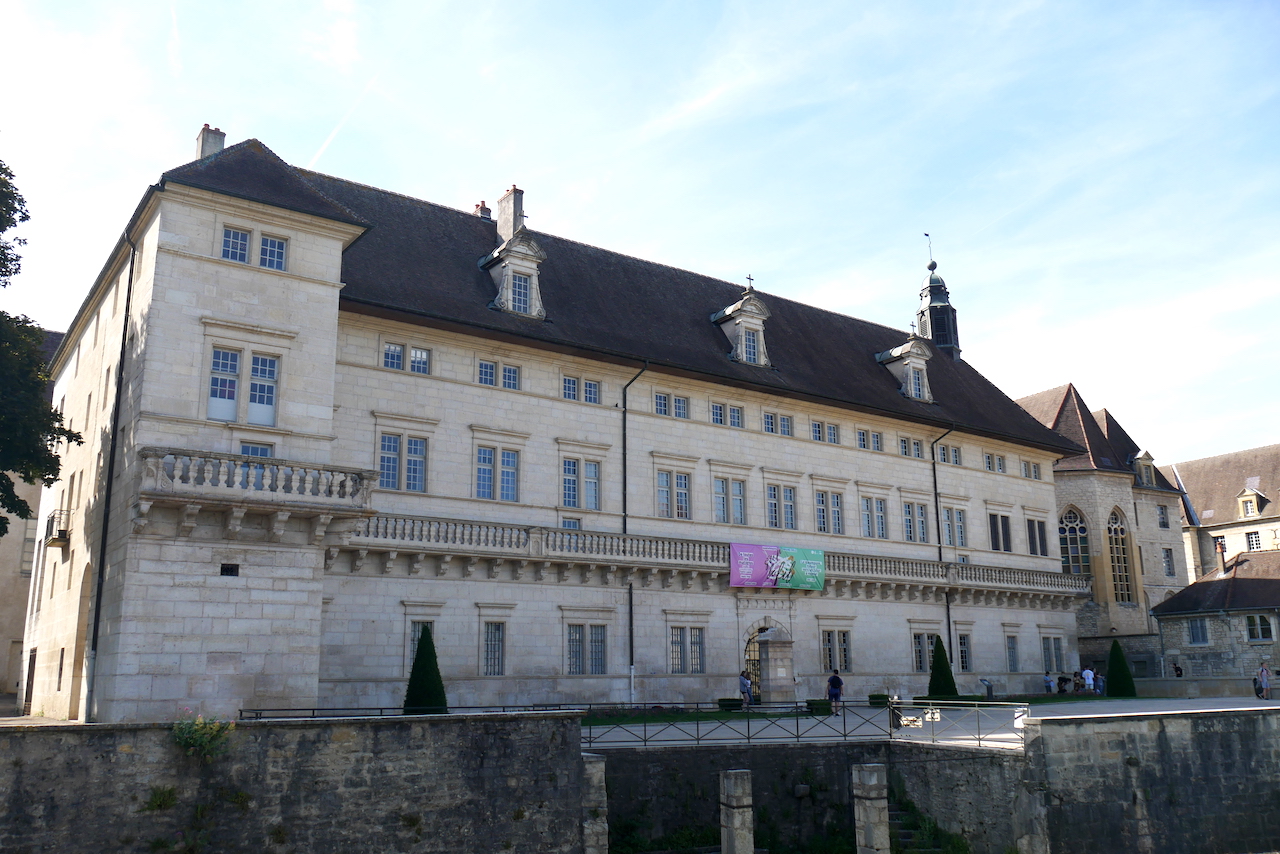
Bourgogne-Franche-Comté
7. Villars-Saint-Georges to Dole
Difficult
8h
32,4km
+323m
-384m
Step
Embed this item to access it offline
You're leaving the Doubs department for the Jura department. The old priory and the church of Courtefontaine will tell you their story. A short passage through the forest of Chaux, the largest deciduous massif in France, you arrive in Fraisans and the history of its Forges, an important industrial estate now undergoing conversion. The Rhone-Rhine canal accompanies you to Dole with a stop at Rochefort-sur-Neron.
7 points of interest

Église de Villard Saint-Georges - Amis de saint Colomban TouristSaint-Georges Church in Villars Saint-Georges
In the 13th century the land of Villars Saint-Georges belonged to Guillaume d'Abbans according to the writings it is about forty people who populate the village. A long time later, in 1583, an important change took place: the estate became a seigneury. Thomas de Jouffroy, lord of Abbans, is at the same time lord of Villars Saint Georges. His descendants kept the fief until 1742, when they sold it to Etienne Pourcy, magistrate. The latter sold it shortly afterwards, in 1763, to Charles-Frédéric Arbilleur, lawyer at the Parliament, descendant of an old bisontine family.
It is difficult to date the construction of the church.
The village offers a gîte next to the church.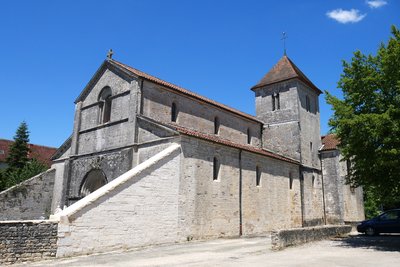
L’église Notre-Dame de Courtefontaine et son cimetière devant la façade - Amis saint Colomban TouristNotre-Dame Church and Courtefontaine Priory
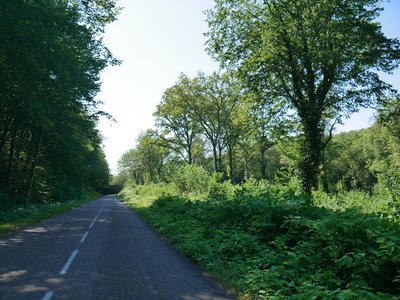
La forêt de Chaux - Amis saint Colomban PanoramicThe Forest in Chaux
This forest is the second largest deciduous forest in France, with 20,493 hectares, oaks and beeches are the most present. From the 13th century onwards, it was home to a population of loggers, charcoal burners, blacksmiths, bark washers... 600 people were still living here at the beginning of the 19th century.
The possibilities offered by the firewood resources of the forest of Chaux determined the choice of this location to build the Royal Saltworks of Arc-et-Senans in 1775.
An important glassworks operated at La Vieille-Loye from 1295 to 1931. The forges of Rans and Fraisans were established in the immediate vicinity.
Le château Caron, Maître de Forge devenu Mairie - Amis saint Colomban HistoricalForges in Fraisans
The Forges de Fraisans are mentioned as early as 1365. The proximity of the wood in the forest of Chaux and the water of the Doubs justifies this implantation.
They were rebuilt after 1670 and improved between 1809 and 1847. The creation in 1854 of the Société des Hauts-Fourneaux, then the Fonderies et Forges de Franche-Comté (Foundries and Forges of Franche-Comté) allowed an important industrial development. The Fonderies et Forges de Franche Comté grouped together 22 regional establishments in the Jura and Doubs and made Fraisans the centre of its activities. In 1865 more than 1500 workers were working at the Forges. Around 1880, the Company dug a gallery at Ougney-Douvot to exploit part of the Keurierian coal basin in Haute-Saône.
Iron ore was first extracted at Dampierre and then from a mine opened in 1846 at Ougney. Firewood came from the nearby Forêt de Chaux.
The 20th century saw the decline of these forges with the closure of the mines. The definitive closure of the site of Fraisans dates from 1936, one year after that of the forges of Rans.
The Forge de Fraisans produced elements for the first floor of the Eiffel Tower and for the Alexandre III bridge in Paris.
The town has a rich real estate heritage of mansions and small castles, one of which has been converted into a town hall, which shows the prosperity of the forges of Fraisans in the 19th century.
A Cultural Centre has been created in a part of the disused factory.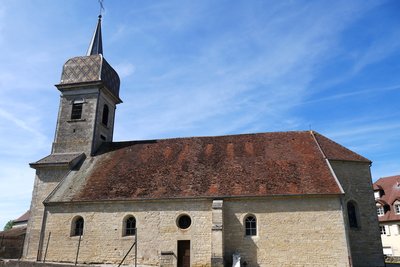
Église Saint-Laurent de Rochefort-sur-Nenon - Amis saint Colomban TouristSaint-Laurent Church in Rochefort-sur-Nenon
As early as the 13th century, texts show the existence in Rochefort of a parish of Saint-Laurent under the patronage of the Abbey of Saint-Paul de Besançon. From the 14th century onwards, under the lordship of the de Chalon family, the village developed rapidly to the detriment of the neighbouring village of Aibe.
From the 14th century onwards, chapels were built, financed by the great families of Rochefort. The 15th century baptistery made of white limestone remains from this period. The pavement of the church also contains tombstones that recall the memory of the graves of the great families of Rochefort from the 13th to the 14th century.
The church of Rochefort suffered degradation in the 17th century when the village was besieged. It was therefore completely rebuilt at the end of the 18th century, a great period of building new places of worship after the end of the Seven Years' War. It began in 1789 and was completed in 1792. It is in the tradition of the hall churches, with, on the west façade, a bell-tower-porch surmounted by a dome in the imperial style, a Franche-Comté tradition.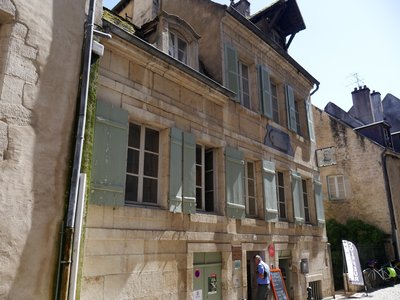
A droite, maison de Louis Pasteur à Dole - Amis saint Colomban HistoricalLouis Pasteur's birthplace in Dole
On the banks of the Canal des Tanneurs, the house where Louis Pasteur was born in Dole represents the starting point of the incredible destiny of the most famous French scientist.
He was one of the pioneers of microbiology, and during his lifetime, he became famous for having developed a vaccine against rabies.
More details: Louis Pasteur Museum website
Vue générale de Dole avec la collégiale Notre-Dame - Amis saint Colomban TouristNotre-Dame de Dole Collegiate Church
In 1277, Alix de Méranie, Countess of Burgundy, in his will wishes to transfer the chapter of canons from Poligny to Dole. However, the religious authorities were opposed to this. It was not until 1304 that his daughter-in-law, Mahaut d'Artois, who had become Countess of Burgundy, succeeded in having the church of Notre-Dame built as a collegiate church.
In 1479, in the context of the troubled succession of Charles le Téméraire, the last sovereign duke of Burgundy with rights in the Comté region, particularly in the Doloise region, the French king Louis XI attempted to conquer Franche-Comté. He seized his capital, Dole, and razed it to the ground.
Shortly after the king's death in 1483, his daughter Anne, then regent of the Kingdom of France, authorized the reconstruction of the city.
The plans for the new collegiate church, which was disproportionately large, were drawn up as early as 1483, but it took more than ten years to raise the money needed for its construction. On 17 December 1508, the City Council and the inhabitants met in the great hall of the Parliament, and decided to found a commission, of nine people, to direct the work and raise new funds by granting chapels, both in the aisles and against the pillars of the nave, with related privileges.
The building was consecrated in 1571 by Mgr Claude de La Baume, Archbishop of Besançon.
During the Revolution, the collegiate church was briefly used as a warehouse, before being converted into the Temple of Reason in 1793, then into the Temple of the Supreme Being in 1794, before becoming a Roman Catholic church again in 1802.
Description
Leave the rue de l'église de Villars-Saint-Georges on the right, Route du Jura, second street on the left, rue des carrières, left at the fork, straight ahead to Clairefontaine, rue du Château d'eau.
- At the crossroads, turn left, rue de Villars, rue de Fraisans, D73, route de Clairefontaine, rue du pont, cross the Doubs, rue de la Gare, turn left, rue de Dampierre, rue de Fraisans, cross the Rhone-Rhine canal, take the cycle path on the left after the bridge.
- At the canal bridge turn right towards Ranchot, Grande Rue, in front of the church on the right, rue de la Chapelle, cross the RN73, rue de la Gare, take the footbridge in front of the parking de la Gare, turn left on the way across the railway, right, rue des Combottes, right junction with D36
- First dirt road on the left, Monteplain, left on tarmac road then right, chemin des Baraques, rue des Fougerets, follow the railway, chemin de l'Ancienne Levée des Romains
- Orchamps, take the level crossing on the left, rue de la Résistance, cross rue de la Libération, rue Louis Pasteur, on the right, rue de la Comédie, before the bridge, take the path along the canal.
- After passing under the railway bridge take the next bridge to change bank towards Dole, next lock on the right cross the canal and left along the canal, Quai Pasteur, left, rue Pasteur, go up to the right, rue Granvelle, second street on the right you arrive at the collegiate church Notre-Dame de Dole.
- Departure : St. George's Church, 1 rue de l’Église, 25 410 Villars-Saint-Georges
- Arrival : Notre Dame Collegiate Church, Place Nationale, 39 100 Dole
- Towns crossed : Bourgogne-Franche-Comté
Altimetric profile
Transport
Gare SNCF à Orchamps et Dole
Report a problem or an error
If you have found an error on this page or if you have noticed any problems during your hike, please report them to us here:






